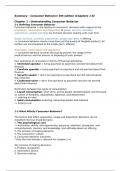Summary – Consumer Behavior: 8th edition (Chapters 1-6)
Chapter 1 : Understanding Consumer Behavior
1-1 Defining Consumer Behavior
Consumer behavior = the totality of consumers’ decisions with respect to the
acquisition, consumption and disposition of goods, services, activities,
experiences, people and ideas by (human) decision-making units over time
Goods, services, activities, experiences, people and ideas = offering
-> consumer behavior means more than just the buying of tangible products, all
entities are encompassed in the simple term ‘offering’
Acquisition, consumption and disposition
-> consumer behavior involves the buying process, the usage of the
product/service and the process of disposing of your product
Four segments of consumers in terms of financial well-being:
1. Stretched spender = living paycheck to paycheck and worried about their
finances
2. Carefree spender = living paycheck to paycheck and not worried about their
finances
3. Security seeker = don’t live paycheck to paycheck but still worried about
their finances
4. Cushioned saver = don’t live paycheck to paycheck and are not worried
about their finances
Distinction between two types of consumption:
1. Liquid consumption: short term, access-based, dematerialized, and focussed
on values of flexibility, adaptability, lightness, and detachment
-> ordering an uber
2. Solid consumption: enduring, ownership-based, and material
-> buying a car
1-2 What Affects Consumer Behavior?
The factors that affect acquisition, usage and disposition decisions can be
classified into four broad domains:
1. The psychological core
-> motivation, ability, and opportunity; exposure, attention, perception, and
comprehension; memory and knowledge, and attitudes about an offering
2. The process of making decisions
3. The consumers’ culture
4. Consumer behavior outcomes
* Only the first domain is relevant for chapters 1-6
The process of making decisions:
1. Problem recognition
2. Information search
3. Decision-making
,4. Post purchase evaluation
Culture = the typical or expected behaviors, norms, and ideas that characterize
a group of people
Reference groups = people whose values you share and whose opinions you
respect
1-3 Who Benefits from the Study of Consumer Behavior?
Which groups use consumer research?
1. Marketing managers
-> to understand what consumers value, so they can develop, communicate, and
deliver appropriate products
2. Ethicists and advocates
-> to protest when they think human rights or ethics are violated
3. Public policy makers and regulators
-> to develop policies and rules to protect consumers from unfair, unsafe or
inappropriate marketing practises
4. Consumers
-> to protect themselves against certain marketing practises and gain knowledge
(5. Academics)
-> to better teach the topic and to perform further research on consumer
behavior
1-4 Making Business Decisions Based on the Marketing Implications of
Consumer Behavior
Market research:
1. How is the market segmented?
-> research helps marketers understand the different groups that make up a
market and whether they can make an offering to appeal to one or more of these
groups
2. How profitable is each segment?
-> research can help marketers identify consumers who have needs that are not
being met and can reveal the size and profitability of each segment
3. What are the characteristics of consumers in each segment?
-> this information can help marketers predict whether the segment is going to
grow or shrink
4. Are customers satisfied with existing offerings?
-> research helps companies come up with new product ideas and new ways to
promote products to current and potential customers
Developing products:
1. Marketers needs to design an offering that matches what consumers want
2. Marketers often use research to determine when and how to modify or tailor a
product to meet the needs of new or existing groups of consumers
3. Consumer research plays a vital role in decisions about choosing a brand and
differentiating it from competing brands and from other brands in the company’s
, portfolio
4. Consumer research can be used to determine the packaging and logos
The offerings’ image should reflect what the product is and how it differs from
competition, the positioning should suggest that the product is superior in one or
more attributes valued by the target market
Perceptual map = a graph used to compare the customers’ perceptions of
different brands
Promotion and Marketing communications decisions:
1. What are the communication objectives?
-> should we enhance brand-name awareness, brand knowledge or encourage
positive emotions
2. What should our marketing communications look like?
-> what combination of words and visuals is going to have the desired result?
3. Where should the advertisements be placed?
-> depends on demographic, lifestyle and media usage data
4. When should we advertise?
-> accounting for different seasons
5. Has our advertising been effective?
-> evaluating whether certain objectives have been fulfilled, testing can also be
done before public release (copy testing or pretesting)
HC1:
Marketing = the social and managerial process by which individuals and groups
obtain what they need and want through creating and exchanging products and
value with each other
Appendix H1: Developing Information About Consumer Behavior
There are two types of data:
1. Primary -> data gathered for its own purpose
2. Secondary -> data collected for one purpose and then used for another
purpose
Different method for collecting data:
1. Survey
= asking a sample of consumers questions to draw quantitative conclusions
about a target population
2. Focus groups
= asking a small group of consumers to discuss an issue or offering, usually led
by a trained moderator
-> can also be done computer-based to keep insights anonymous
3. Interviews
= one-on-one discussions in which an interviewer asks a consumer questions
related to their behaviour or decisions
4. Storytelling
= asking consumers to tell stories about acquisition, usage, or disposition






